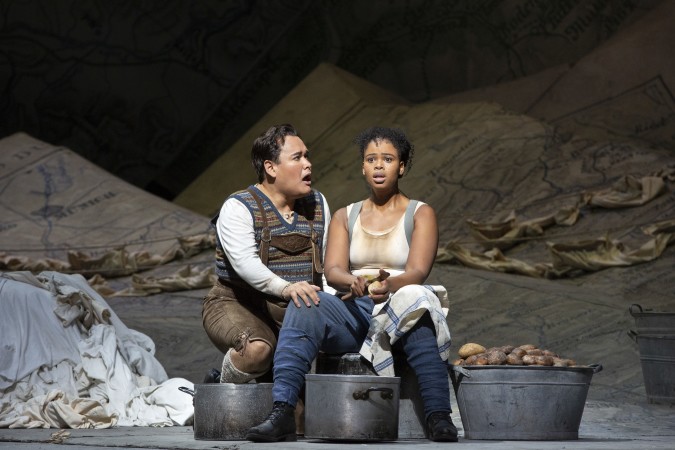 United States Donizetti, La fille du régiment: Cast, Chorus and Orchestra of the Metropolitan Opera / Enrique Mazzola (Conductor) broadcast live from the Metropolitan Opera New York to Dundonald Omniplex, Belfast, 2.3.2019. (RB)
United States Donizetti, La fille du régiment: Cast, Chorus and Orchestra of the Metropolitan Opera / Enrique Mazzola (Conductor) broadcast live from the Metropolitan Opera New York to Dundonald Omniplex, Belfast, 2.3.2019. (RB)

Production:
Production – Laurent Pelly
Stage Director – Christian Räth
Set Designer – Chantal Thomas
Costume Designer – Laurent Pelly
Lighting Designer – Joel Adam
Choreographer – Laura Scozzi
Cast:
Marie – Pretty Yende
Tonio – Javier Camarena
Marquise of Berkenfield – Stephanie Blythe
Sulpice – Maurizio Muraro
Duchess of Krakenthorp – Kathleen Turner
Live in HD Director – Gary Halvorson
Live in HD Host – Nadine Sierra
Donizetti wrote La fille du régiment between 1838-40 when he was living in Paris working on Les martyrs. After a bumpy start – it was panned by no less a figure than Hector Berlioz – it became enormously popular and it has remained in the mainstream repertory ever since. The plot involves an orphan called Marie who is the eponymous daughter of the 21st regiment of the French army. Marie is in love with Tonio, a Tyrolean and he enlists in the French army to try to win both her and the regiment’s approval. Alas, the course of true love never did run smooth. The Marquise of Berkenfield recognises Marie as the illegitimate daughter who she abandoned and arranges to marry her off to the Duke of Krakenthorp. Tonio and the regiment arrive to rescue her from the Krakenthorps and the Marquise finally relents and gives Marie permission to marry Tonio. The opera is a winning comic confection and a real crowd pleaser.
Laurent Pelly’s production updates the action from the Napoleonic Wars to the First World War. When the opera opened we were greeted with a rag-bag band of villagers ready to defend the Tyrol from the French invaders. Quite a few of the men were wearing tin pots on their head and were carrying pitchforks. With the arrival of the French 21st regiment, Pelly and his team used enormous maps in the shape of the Alps to form a backdrop to the action. There was a lot of physical comedy from both the cast and chorus which the audience enjoyed enormously. At the start of the second act we were greeted by four men all wearing French maid outfits doing exaggerated ballet movements in a large drawing room (it reminded me of Freddie Mercury in the video of ‘I Want to Break Free’). In the final scene, Tonio rode to rescue Marie on top of a tank. The audience in the cinema loved it and broke into spontaneous applause with the Met audience.
Pretty Yende and Javier Camarena were both superb in the roles of Marie and Tonio respectively. Yende’s Marie transformed from a seasoned tomboy ironing the underwear of the soldiers to a bashful girl exchanging shy looks and big smiles with Camarena’s Tonio. In Act II she was petulant and out of sorts in her pretty dress. Yende handled the physical comedy brilliantly and at one point managed to produce a blazing high note while being hoisted into the air by the regiment. She executed Donizetti’s coloratura runs with razor-sharp precision bringing brilliance and flair to the vocal line. She sang the Act I aria ‘Il faut partir’ with enormous poignancy and beauty of tone and produced some gorgeous floating lines in Act II’s ‘Par le rang’.
Mexican tenor, Javier Camarena, embodied the love-struck Tonio to perfection. In Act I, he mixed to winning effect puppy dog enthusiasm with bashful glances at Marie. As the opera progressed, we watched him transform from a love stuck Romeo into a gallant soldier. The highlight of the evening was Camarena’s rendition of ‘Ah! Mes amis’ which famously requires the tenor to hit 9 high C’s. Camarena’s performance of the aria was a tour de force and the high C’s rang out gloriously. The Met audience responded with ecstatic applause and a standing ovation, forcing Camarena to sing the aria one more time (quite a feat to hit so many high C’s in succession!). While Camarena brought star quality to the role, he also showed himself an accomplished and generous performer in the ensemble numbers.
Stephanie Blythe gave an accomplished performance as the Marquise of Berkenfield and I enjoyed her verbal sparring with Kathleen Turner’s Duchess of Krakenthorp. Turner is, of course, more familiar to us from Hollywood movies but she threw herself into this non-singing operatic role with gusto. We were informed at the start of the opera that Maurizio Muraro had a cold and his voice was not at his best. In the circumstances Muraro acquitted himself extremely well in the role of Sulpice.
Enrique Mazzola and the Metropolitan Opera Orchestra did an excellent job throughout. The opening horn calls at the start of the Overture were warm and arresting, setting the scene perfectly. Mazzola kept the entries tight and succeeded in building up a head of steam as the music progressed. There was a sense of whimsy and delight in the march rhythms and an infectious sense of fun shone through. There were some wonderful colour changes and I was particularly impressed with the poignancy which Met’s principal oboist brought to Yende’s final Act I aria.
This was a sparkling performance of La fille from the Met and Yende and Camarena proved a winning combination. Great stuff!
Robert Beattie
For more about The Met: Live in HD click here.
